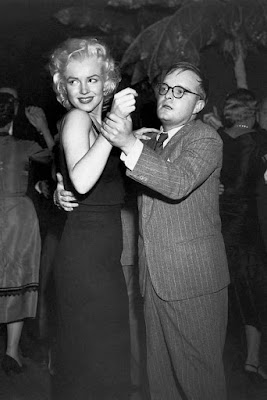Last year for National Poetry Month I wrote a couple of blog posts about anthologies of poems by Alabama authors. One focused on Alabama Poetry published in 1945 and edited by Louise Crenshaw Ray. Another looked at the Anthology of Alabama Poetry 1928 published by the Alabama Writers Conclave. In this post for the annual poetry celebration, I want to discuss a particular poet with state connections, Sara Henderson Hay.
She was born on November 13, 1906 in Pittsburgh, Pennsylvania, but grew up in Anniston. Her parents were Daisy Henderson [Baker] Hay and Ralph Watson Hay. The 1940 U.S. Census gives Daisy's birthplace as Alabama and the year as about 1878; she died in Anniston on August 27, 1966. Ralph was also born in Pittsburgh on February 9, 1873, and died there on February 23, 1938. Hay's parents were married in Anniston on November 15, 1905.
The family seems to have done a lot of back-and-forth between Pennsylvania and Alabama. According to his Find-A-Grave listing, her father was a superintendent with Samuel W. Hay's Sons , & Manufacturers Light & Heat Co. and salesman with Oil Well Supply Co., all in Pittsburgh. Ralph's father was Samuel W. Hay, so presumably that one was the family business. Since Anniston had many metal and pipe industries, Ralph may have lived in both places and travelled back and forth for business interests.
Sara received her education before college in Anniston. In the 1880's one of Anniston's founders Samuel Noble established two private schools affiliated with the Episcopal Church, Noble Institutes for Boys and Girls. Established in 1886, the Noble Institute for Girls was located at the corner of 11th Street and Leighton Avenue. The boarding school closed in 1914, and the building later burned. The day school, which Hay presumably attended, closed in 1922. In that same year a new brick Anniston High School opened, which Hay attended.
At age 10 she had published a poem about golf in Judge Magazine and in high school published in the Anniston Star newspaper. She continued writing and publishing poetry while in college. She left Anniston to enroll at Brenau College in Georgia from 1926 until 1928, then moved to New York City and graduated from Columbia University in 1931.
Hay worked in the Rare Book Department at Charles Scribner's Sons publisher from 1935 until 1942. After Columbia she had started with the company as a secretary in the editorial offices and then worked in the firm's bookstore. During this period her poems began to appear in various magazine and anthologies. While there she was an editor on Stevenson's Home Book of Shakespeare Quotations, published by Scribner's in 1937.
In 1935 while at Scribner's Hay was able to tour Europe as secretary to Gladys Baker, a syndicated newspaper columnist. Baker had moved to the Magic City in 1926 to begin working for the Birmingham News. Small world, isn't it? I've yet to discover how the two women met, but on the tour they met with Pope Pius XI, Mussolini, Ataturk and other notables.
Hay resumed work at Scribner's, continued writing poetry and published poetry and fiction reviews for the Saturday Review of Literature. In 1939 her second book was published by Alfred A. Knopf, another major New York publisher. I have included a number of images from This, My Letter below, including two from her "To My Small Son" series about an imaginary child.
In 1938 and 1940 she recorded 28 of her poems at the City College of New York; they are listed at that link. In 1953 they were copied for the Archive of Recorded Poetry and Literature at the Library of Congress.
During the 1950's and 1960's Hay continued to publish collections of poetry. The Delicate Balance [Scribner] appeared in 1951 and The Stone and the Shell [University of Pittsburgh Press] in 1959. In 1963 Doubleday published The Story Hour; see some comments about it below. Doubleday also published her final book The Footing on the Earth in 1966.
The 1951 collection The Delicate Balance won the Edna St. Vincent Millay Memorial Award from the Poetry Society of America. The Kentucky Poetry Review published an issue devoted to her work in 1980.
Hay was married twice. Her first husband was Raymond Holden [1894-1972], a novelist, poet and publisher she married in 1937. Hay was the third of his four wives and the union apparently did not last long. On January 27, 1951, she married Nikolai Lopatnikoff, and they remained together until his death in 1976. He was a composer, and you can see a photo of him in the classroom taken by famed photographer W. Eugene Smith here. He taught music composition at Carnegie-Mellon University in Pittsburgh from 1945 until 1969. I have found no indication that Hay had any children.
Sara Henderson Hay died on July 7, 1987, in Pittsburgh. Her death was covered by the New York Times. She and her second husband are buried in Homewood Cemetery in that city.
I have found these two items of scholarship on Hay's work:
Joyce, Christa Mastrangelo. "Contemporary Women Poets and the Fairy Tale." Fairy Tales Reimagined: Essays on New Retellings (2009): 31-43.
Wilson, Dorothy Ann. Irony and Satire in the Poetry of Sara Henderson Hay. Diss. Indiana State College (Pa.), 1964.
I also found an essay by Alabama's eighth poet laureate, Helen F. Blackshear, "The Poetry of Sara Henderson Hay" in her collection Southern Smorgasbord [1982].
Images and some more commentary are below. I have included many from Hay's second poetry collection, since that is the only book of hers I own. I've also included one related to a mystery I've yet to solve.
This special issue of Sagetrieb published in 2000 featured Hay on the cover in a photo taken in 1973.
Source: Anniston Star 22 October 1950































